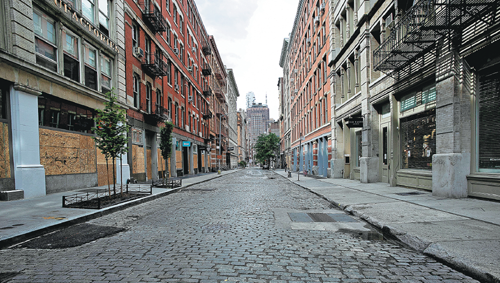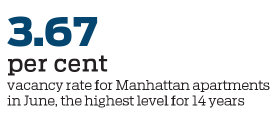Pandemic eats into Manhattan property market
Commercial and residential demand takes a hit
The slogan "New York Tough" has been used by Governor Andrew Cuomo at his daily briefings to describe how the state has stood up to the coronavirus pandemic.
Now, with the state and city of New York experiencing one of the lowest transmission rates for the virus since the start of the outbreak, questions are being asked as to whether the Big Apple is tough enough to make a comeback.
Many observers believe it will rebound just as it did after the attacks on Sept 11,2001, despite forecasts that the metropolis is doomed.
However, many aspects of life in the city, especially Manhattan, have been severely hit from luxury boutiques to small mom-and-pop neighborhood stores. There has been a significant reduction in the number of restaurants. Shows staged by Broadway theaters, the New York City Ballet, Metropolitan Opera and Carnegie Hall have been cancelled, along with the New York City Marathon.
Two of Manhattan's biggest mainstays are also struggling-the residential and commercial real estate markets.
The residential market has plummeted by a record level, reeling from the combined effects of COVID-19 and thousands who have fled the city for second homes or short-term rentals.
The commercial market is feeling the impact of employees working from home, possibly never returning to office space and leaving behind vacant square footage that will affect commercial rents as tax revenue.
Sales in the residential market during the pandemic have fallen by 54 percent year-on-year.
In June, the number of contracts signed for apartments fell by 76 percent compared with the same period last year. At least 90 percent of sales in the second quarter were signed before the onset of the pandemic.
No figures have been disclosed for the total area of Manhattan office space left vacant by those working from home, but several companies have decided against employees coming into the city.
The pandemic's impact on commercial stores is clearly visible in popular shopping areas such as Madison Avenue, Fifth Avenue and Lower Manhattan. "For rent" signs in store windows have replaced displays of shoes, jewelry, designer outfits and other luxury goods.
A report released recently by real estate company Douglas Elliman showed that the median sales price for apartments fell by 17.7 percent from last year to $1 million, the biggest decline for a decade. According to real estate brokerage Compass, there were only 1,147 sales in Manhattan in the second quarter, the lowest number on record.
Jonathan Miller, a New York appraiser and the author of the report, told The New York Times: "This is what you get when the market is not able to function. It's an extreme moment, to put it mildly."
In addition to the pandemic, the residential market was hit by Cuomo banning in-person apartment showings by brokers from mid-March to June 22 to stem the spread of COVID-19.
Patrick W. Smith, associate real estate broker with the Corcoran Group, said the ban dealt the market a huge blow.
"I cover Long Island City, Manhattan and Brooklyn. During the shutdown, with in-person showings not permitted, new contract signings declined by approximately 90 percent compared with the same period last year. It was a very large drop," he said.
Rebound anticipated
Manhattan isn't the only area where residential sales have plummeted. A report by the Real Estate Board of New York, or REBNY, a trade association, showed that from Jan 1 to March 31 year-on-year residential sales in all five boroughs of New York City fell from $10.5 billion to $8.7 billion.
The number of residential sales transactions in the boroughs-including condominiums, cooperatives and family houses-dropped from 10,382 last year to 8,702 this year, the lowest figure recorded since the fourth quarter of 2011.
James Whelan, REBNY's president said: "Market indicators warned New Yorkers that the housing market was entering a downturn even before the coronavirus pandemic caused an unprecedented public health and economic crisis in New York City."
However, Smith and other real estate brokers said that despite the problems caused by the pandemic, the property market could rebound in the third quarter as New York gradually reopens. The city entered the third phase of reopening on July 6.
"Recently the state said we could do in-person showings, with certain restrictions. As soon as that happened, we saw an immediate increase in signed contracts, showings and offers," he said.
Smith added that there had been some pent-up demand and suggested that activity could increase in the third quarter.
Although there is optimism about a market recovery, there is no guarantee that the thousands of residents who fled to the Hamptons, upstate New York, Connecticut and elsewhere to escape the virus will return.
An estimated 60,000 New Yorkers who have left the city has resulted in vacancies for Manhattan apartments rising to the highest level in 14 years.
In June, the number of new lease signings was the lowest for nearly 10 years, according to the Elliman report, with the vacancy rate standing at 3.67 percent, compared with 1.61 percent in the same month last year.
Median rental prices in Manhattan fell by 4.8 percent from June last year to $3,378 a month, erasing rises seen in recent years, the report said.
With the city's residential market struggling, its commercial property sector could be drastically affected by people working from home, especially if the traditional office is viewed as "unhealthy", despite design changes.
Some researchers and company executives think people will continue to go to an office for work, but increasing numbers may operate from home two or three days a week.
As a result, questions are being asked about the merits of continuing to pay high rents for Manhattan office space.
Several leading employers have decided to allow employees to work from home, including the research company Nielsen. Its 3,000 workers in the city no longer need to be in the office full-time and can operate from home for most of the week.
David Kenny, Nielsen's CEO, said the company plans to convert its New York offices into team meeting spaces where workers gather once or twice a week.
"I have done an about-face on this," he told The New York Times, "If you are coming in and working at your desk, you certainly could do that from home."
He added, "We have leases that are coming due, and this is absolutely driving those kinds of decisions."
Real estate company Halstead has 32 branches and more than 1,000 agents across the city and region, but its CEO Diane M. Ramirez now conducts business through video calls.
She asked, "Looking forward, are people going to want to crowd into offices?"
Facebook, Google and The New York Times have extended working-from-home practices until the end of this year, while Twitter has told its hundreds of employees in the city they can work remotely all the time if they want to and if their positions allow them to do so.
Global financial services company JPMorgan Chase, which until last year was the largest office tenant in New York City, said it is reviewing the number of workers who will be allowed to return to its offices.
If a large number of companies opt for employees working from home rather than in the city, this could lead to the size of many offices being reduced, saving employers a significant amount and leaving landlords with empty floors and falling rents as demand declines.
There is also the issue of real estate taxes, which provide about one-third of New York's revenue and help pay for basic services such as the police and trash collection. Falling tax revenue would worsen the city's financial crisis and hinder its recovery.
If large numbers of workers no longer travel into the city five days a week, the mass transit system, which is already in the red due to a drastic fall in the number of users during the pandemic, could see revenue continue to fall.
Thousands of businesses catering to white-collar employees in downtown areas, including restaurants, bars, convenience stores and upscale shops, could experience a decline in customers which would erode profit margins and force more closures.
Reduced sales tax revenue would eat into the city budget, leading to fewer services and strengthening the desire to work from home.
Increased productivity
Kate Lister, president of research and consulting company Global Workplace Analytics in San Diego, California, said employees working from home half the time would save from $2,500 to $4,000 a year by spending less on travel, food and parking. Reduced commuting time would save such workers the equivalent of 11 days a year.
"Home will become a place for increased productivity and more contemplative work-even with the cacophony of children and pets," Lister said.
"People working from home are more satisfied and more efficient. Does it make sense to traipse into town to go to the office and then across town to meet a client when it can be done on Zoom?"
Operating from a spare bedroom rather than an office several days a week might also do away with the need to buy expensive clothes for work, as most employees don't feel the need to dress up for video conferences, Lister said.
However, many insiders feel that office space will always be in demand.
Anthony E. Malkin, CEO of Empire State Realty Trust, which owns the Empire State Building and eight other properties in Manhattan, said large industries, including a fast-growing technology sector, would drive an economic rebound and the desire for office space.
The absence of social contact which people are experiencing today is not sustainable, Malkin said. "Can you pay bills from home? Can you process things from home? Yes. But can you work as a team from home? It's very challenging," he said.
Mary Ann Tighe, chief executive of commercial real estate services company CBRE's New York Tri-State Region, said offices will undoubtedly change, with some employees working remotely, but workers will still want face-to-face interaction.
Referring to working-from-home arrangements, she said, "This isn't the nature of office work."
Steven Roth, chairman of Vornado Realty Trust, one of the largest commercial landlords in New York City, said during a company earnings call this month: "We do not believe working from home will become a trend that will impair office demand and property values. The socialization and collaboration of the traditional office is the winning ticket."
Contact the writers at scottreeves@chinadailyusa.com


















